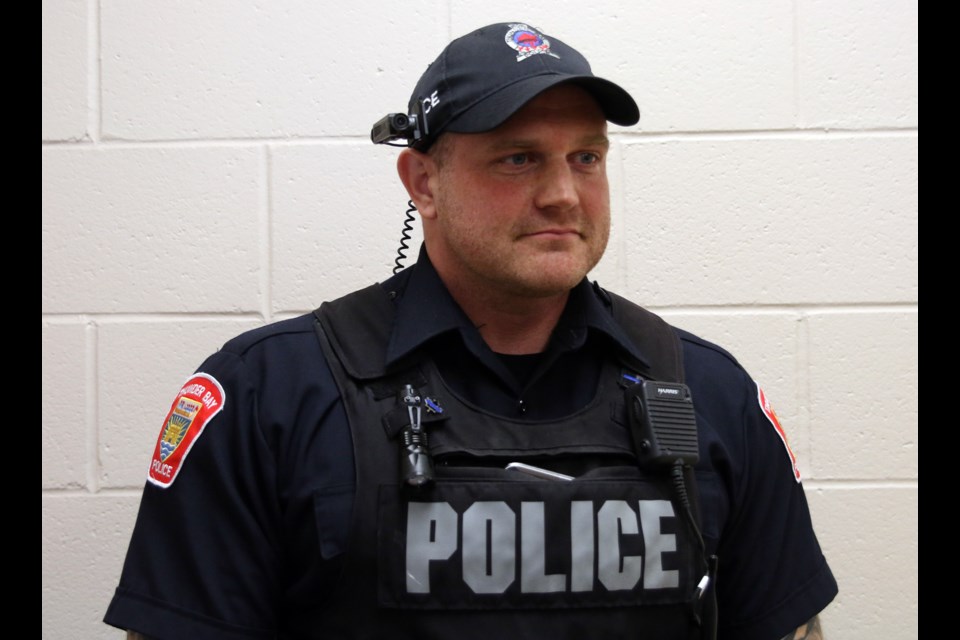THUNDER BAY - The introduction of body-worn cameras in the Thunder Bay Police Service was initially greeted with a certain degree of anxiety and fear among the members. While that has since changed, implementing the system across the entire service will require not only strong management but also a change in culture.
“The management of that change is significant,” said Sgt. Gordon Snyder with the traffic unit of the Thunder Bay Police Service. “It’s more than an organizational change, this is a cultural change that needs to occur in the police service. I think in time the officers will understand the reasoning behind it and the importance of it as with how it happened with the pilot project as well.”
Snyder presented the viability review of body-worn cameras to the Thunder Bay Police Services Board on Tuesday following a pilot project of the system that began last November and concluded in April. The pilot included six members of the traffic unit outfitted with cameras and expanded to three more members in the uniform patrol branch in January 2019.
Over the course of the five-month pilot, the nine officers recorded more than 3,000 videos and in the early stages the pilot was reporting positive results. Out of 1,805 incidents recorded, 1,433 involved traffic enforcement and resulted in 855 charges. The remaining incidents included 107 criminal, 48 other provincial offenses, and 217 listed as other investigations.
The addition of body-worn cameras was meant to enhance transparency and public trust, enhance officer accountability, de-escalate volatile situations, collect evidence, and protect officers from unfounded allegations of misconduct. It was also one of the 44 recommendations reached in the final report of the Office of the Independent Police Review Director.
“Policing is going through some significant transformations across North America,” Snyder said. “We’ve seen it in the U.S. for quite some time now with big focus on transparency and accountability.”
However, there was some hesitancy among the officers during the pilot project, which Snyder said is to be expected with any kind of significant change.
He used the example of any other individual who was suddenly going to be recorded during every moment on the job. So for officers, there was a certain level of fear and anxiety that every move they made would be scrutinized.
“With body-worn cameras, officers are wearing cameras for their entire shift, they are expected to record under specific circumstances with the public, also there are circumstances when these cameras can be turned on,” Snyder said.
“It is difficult, it is learning something new, it is unknown. A change of this magnitude, I do expect some resistance, it’s just natural. The importance is to properly manage that to ensure the rationale for the change is clear and specific to the officers and to manage it in a specific way to ensure success.”
The perception among the participating officers did change and Snyder said the officers did not want to go back to not wearing the cameras following the conclusion of the pilot project.
But Snyder acknowledges there will continue to be resistance as the program rolls out to include the entire complement of 130 officers, so the success of the program will depend on proper management and a shift in culture at the Police Service.
“I can’t stress enough that the management of this being rolled out to the service is critical,” he said. “If that change isn’t there, there is going to be resistance.”
Increased workloads
But creating that change in the Police Service is not the only hurdle to overcome in order to implement this system into the entire service.
With so much video evidence being recorded, workloads will increase. While officers did not see a substantial increase in workload due to the cameras, those in court services were not only overwhelmed with the added workload of redacting videos for court proceedings, they were also exposed to upsetting content regularly.
“All of the court staff stated there has been a dramatic increase in their workload as a result of this pilot project,” the viability report reads. “Some staff have indicated their workload has more than doubled and that other duties have fallen behind as a result.”
“One court staff member advised that they have found some of the video upsetting due to how the people in the video were interacting with the officers and others,” the report continued. “Some staff members advised that as court staff they are not accustomed to some of the behavior that they see on the videos.”
Snyder said the management of the workload of the digital evidence will be the second crucial step in ensuring this project works, but he is confident that technology will make things easier.
“We are seeing advances in technology all the time, even throughout this pilot project,” he said. “The advances in technology have changed significantly, the amount of time it takes to do certain kinds of redactions. As it stands, we need more assistance on that area to be able to adequately process all the videos that will be recorded.”
With the pilot project and analysis concluded, the Police Service has received expressions of interest from vendors and will be preparing requests for proposals that should be going out in the next couple of months.
Snyder said the service is hoping to have something in place by the end of the year, though a roll out of the body-worn cameras across the entire service will take time.
“We need to be in a place to properly roll this out,” he said. “It wouldn’t be a switch in a moment.”
Throughout the pilot, Snyder said the public has continuously been supportive of the body-worn cameras.
